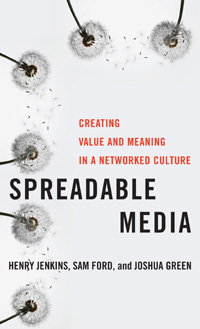Last updated on January 30, 2017
I’m getting back into the swing of things with the dissertation this week and my book and website of the moment are Spreadable Media: Creating Value and Meaning in a Networked Culture (Henry Jenkins, Sam Ford, and Joshua Green, 2013).

The work is aimed at media/culture critics, communication scholars, and businesses (an exceptionally inclusive audience already), and I think there are some significant takeaways for my dissertation (which focuses on historical significance, i.e., value and meaning, in a digital world) and for teaching more broadly.
I especially appreciate the author’s exploration of “sticky” vs. “spreadable” media. According to the authors, sticky content, as first articulated by Malcolm Gladwell in The Tipping Point (2002), is created by a particular person or group and then placed in a single location on the web. The creator then makes an effort to attract the presumed audience to this location and counts the votes or views or purchases in order to measure the success of their strategy. Spreadable content, by contrast, is meant to be easily shared on a wide variety of platforms. In the creation of spreadable content, creators cede much of the control over the content’s virtual life to the audience.
Jenkins and Ford sum up the difference:
“Sticky sites often incorporate games, quizzes, and polls to attract and hold the interests of individuals. The participatory logic of spreadability leads to audiences using content in unanticipated ways as they retrofit material to the contours of their particular community. Such activities are difficult for creators to control and even more difficult to quantify” (p. 6).
For me, this resonates with much of the conversation surrounding ed tech at the moment. Some of the current literature focuses on “sticky” methods – How can we gamify our grading structures or activities so they hold students’ interest? If we introduce periodic polls or quizzes in class, can we get students to tune in to us (instead of Facebook) more frequently?
There is, though, also a strain of think pieces, books, and Twitter conversations more interested in “spreadable” methods – How can we communicate content (especially utilizing technology and digital media) in a way that leaves it open to multiple interpretations, remixes, and appropriations by our students?*
As someone who teaches a subject (ancient/medieval history) that isn’t always apparently relevant to students, I think I often find myself using “sticky” methods in the classroom. I give my most enthusiastic performances when students have the least energy, I utilize entry and exit quizzes, and I encourage the use of a Padlet for questions in class so we can take breaks to answer those questions. These are all tactics to attract and hold the interests of students.
I do use some “spreadable” methods as well. The student blogging project is perhaps the best example of this. I try to give students the historical, technological, and methodological tools they’ll need to write their posts and I provide some suggested topics and sources of information. What they do with a given topic or post format, however, is up to them – and out of my control.
That means when I suggested to a group that the best format for their topic might be a BuzzFeed-like listicle composed on our class website…they created an honest-to-goodness BuzzFeed article instead. Or when I asked that they only use Creative Commons/fair use/public domain images, they used GIFs to illustrate their post instead of or in addition to other images. (Do pardon the images not working in some of these posts. That’s a WordPress issue, not the students’ fault.)
Jenkins and Ford note that there is a place for both sticky and spreadable media in the digital world, but their preference is pretty clearly for the latter (p. 8). I think there is room for sticky and spreadable methods of teaching as well, but I want to think a bit more about when each is most effective for communicating content and helping students create meaning and value around their study of history.
*I hearby promise to come back and add examples of these diverse conversations at some later date….
